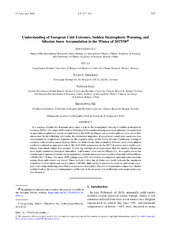Understanding of European Cold Extremes, Sudden Stratospheric Warming, and Siberian Snow Accumulation in the Winter of 2017/18
Peer reviewed, Journal article
Published version

View/
Date
2020Metadata
Show full item recordCollections
- Geophysical Institute [1187]
Abstract
It is unclear whether the Eurasian snow plays a role in the tropospheric driving of sudden stratospheric warming (SSW). The major SSW event of February 2018 is analyzed using reanalysis datasets. Characterized by predominant planetary waves of zonal wave 2, the SSW developed into a vortex split via wave–mean flow interaction. In the following two weeks, the downward migration of zonal-mean zonal wind anomalies was accompanied by a significant transition to the negative phase of the North Atlantic Oscillation, leading to extensive cold extremes across Europe. Here, we demonstrate that anomalous Siberian snow accumulation could have played an important role in the 2018 SSW occurrence. In the 2017/18 winter, snow depths over Siberia were much higher than normal. A lead–lag correlation analysis shows that the positive fluctuating snow depth anomalies, leading to intensified “cold domes” over eastern Siberia (i.e., in a region where the climatological upward planetary waves maximize), precede enhanced wave-2 pulses of meridional heat fluxes (100 hPa) by 7–8 days. The snow–SSW linkage over 2003–19 is further investigated, and some common traits among three split events are found. These include a time lag of about one week between the maximum anomalies of snow depth and wave-2 pulses (100 hPa), high sea level pressure favored by anomalous snowpack, and a ridge anchoring over Siberia as precursor of the splits. The role of tropospheric ridges over Alaska and the Urals in the wave-2 enhancement and the role of Arctic sea ice loss in Siberian snow accumulation are also discussed.